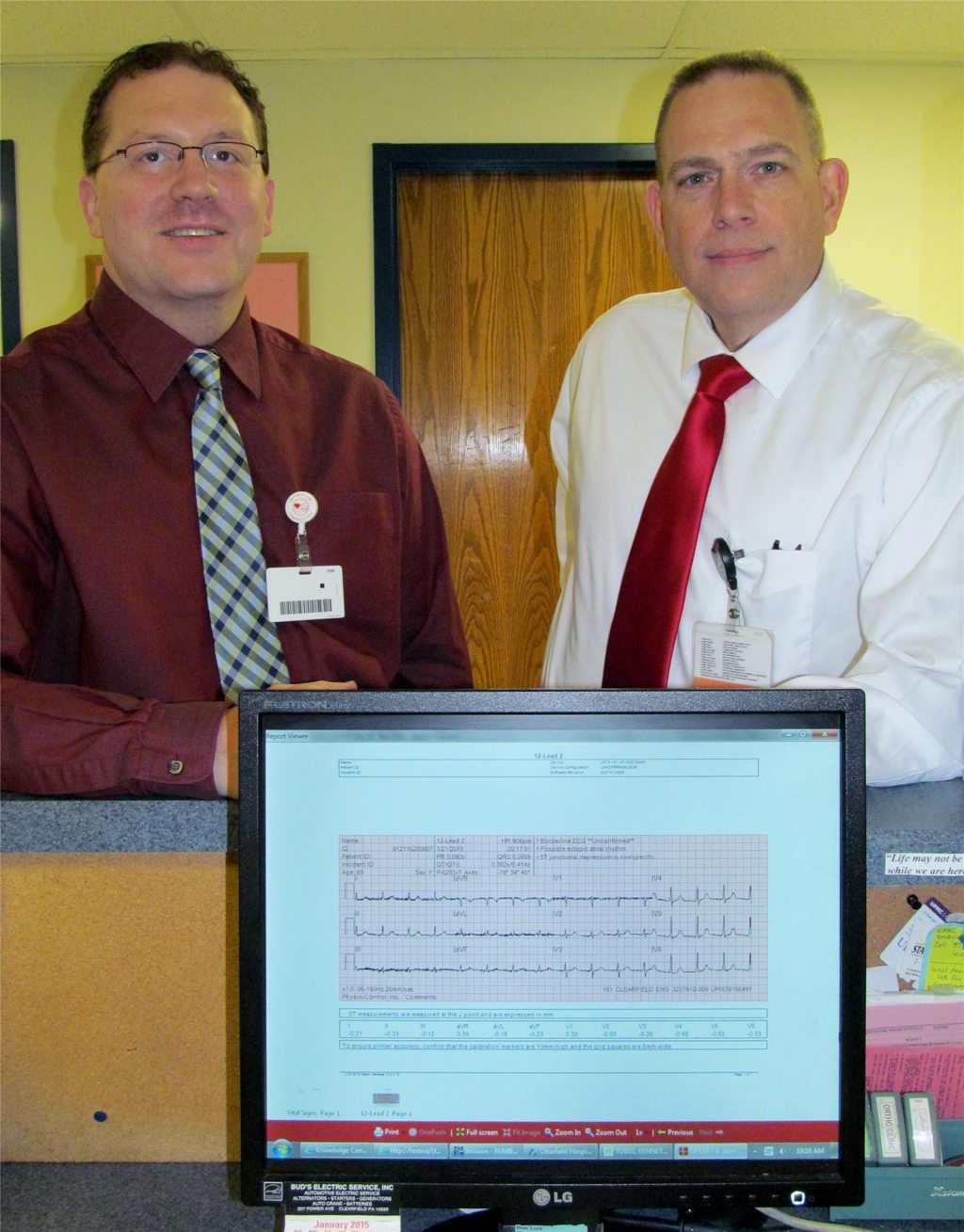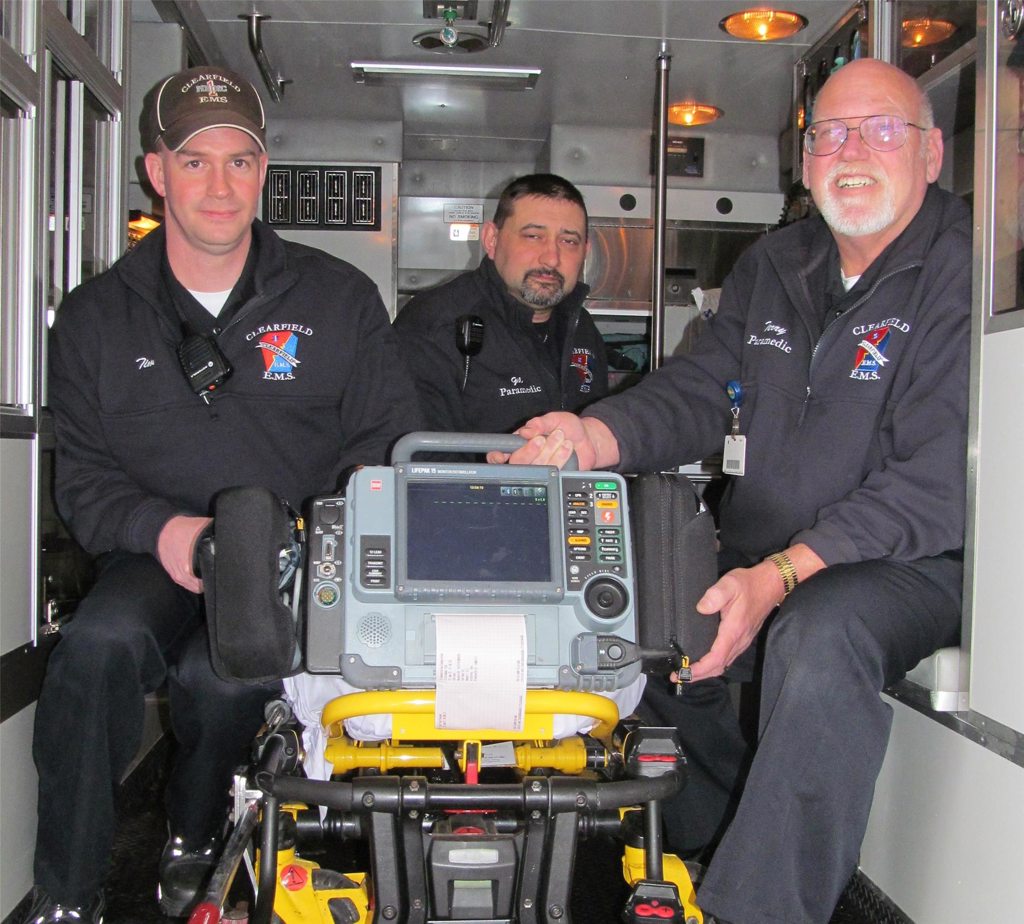Penn Highlands Clearfield Emergency Department Adds New Cardiac Technology

Penn Highlands Clearfield uses LifeNet, a system which involves the use of portable data-gathering monitors at the patient’s home or en route to the hospital. The monitors, used by emergency medical responders, take the patient’s vital signs and record the electrical activity of the heart. This information is electronically transmitted to the emergency department, where doctors review the information prior to the patient’s arrival. Shown at the LifeNet computer terminal at Penn Highlands Clearfield are David Bundy, D.O., assistant medical director of emergency medicine at Penn Highlands Clearfield, left, and John Bacher, BSN, RN, PHRN, director of the Penn Highlands Clearfield emergency department.

The LifeNet system helps Clearfield Emergency Medical Services improve outcomes for heart attack patients. EMS personnel acquire valuable patient information in the field, which, in turn, is transmitted to the hospital while the ambulance is en route. This allows hospital teams to prepare for the patient, saving valuable time. Shown, from left, are Tim Lumadue, deputy director; Gil Stevenson, deputy director; and Terry Wigfield, executive director, all of Clearfield EMS.
A new computer software and cardiac response protocol at Penn Highlands Clearfield are reducing the length of time between identifying a heart attack and providing potentially life-saving treatment.
“With heart disease being the No. 1 health threat in Clearfield County, it’s crucial we offer the latest in cardiac testing and treatment in our emergency department. We have excellent cardiac resources in place, but are always striving to incorporate the latest practices and technology,” stated David Bundy, D.O., assistant medical director of emergency medicine at Penn Highlands Clearfield.
In September, Penn Highlands Clearfield began using LifeNet, a system which involves the use of portable data-gathering monitors at the patient’s home or en route to the hospital.
The monitors, used by emergency medical responders, take the patient’s vital signs and record the electrical activity of the heart (electrocardiogram). This information is electronically transmitted, using a secure platform, to the Penn Highlands Clearfield emergency department, where doctors review the information prior to the patient’s arrival.
“Having the ability to have critical, time-sensitive information sent to us immediately from EMS prior to arrival allows us to get the patient to the appropriate treatment as quickly as possible. This tool is invaluable in allowing us to get cardiac patients having acute myocardial infarction (heart attack) to the facility able to treat them most appropriately and prevents delays in treatment that could be detrimental,” noted Joseph Clark, D.O., regional medical director of emergency services for Penn Highlands Healthcare.
Terry Wigfield, executive director of Clearfield Emergency Medical Services, agreed and added, “Information technology has allowed EMS to transmit information to the hospital in minutes. The best decision can then be made by medical command if the patient needs to go to Penn Highlands Clearfield to be stabilized or if EMS can go directly to The Heart Center of Penn Highlands DuBois. Time is muscle and our goal is to save as much as we can for a better outcome for the patient. We are happy to partner with Penn Highlands Clearfield on this project.”
Moshannon Valley Emergency Medical Services also has LifeNet capability, according to co-director Fred Ferguson. He, too, said having the technology is a great benefit and provides patients with a better chance for a successful outcome.
Penn Highlands DuBois and Penn Highlands Elk also have LifeNet capability, according to Donald Lemmon, assistant vice president of The Heart Center, The Lung Center and emergency services at Penn Highlands DuBois.
Lemmon said LifeNet technology complements the American Heart Association’s national initiative, Mission: Lifeline, to advance systems of care for ST-elevation myocardial infarction (STEMI), a severe heart attack caused by prolonged period of blocked blood supply that affects a large area of the heart.
Approximately 400,000 Americans suffer from a STEMI heart attack each year, which carries a substantial risk of death and disability.
In addition to adding LifeNet, the Penn Highlands Clearfield emergency department recently enhanced its cardiac response protocol to further improve diagnosis and treatment. Dr. Bundy said the new policy builds on current practices to establish rapid treatment and care to patients who present to the emergency department with suspected coronary distress.
The policy calls for emergency staff to perform a series of initial diagnostic tests and administer medication within 10 minutes of the patient’s arrival in the emergency department.
John Bacher, BSN, RN, PHRN, director of the Penn Highlands Clearfield emergency department, explained that when one is experiencing a heart attack, every moment counts. He said some people don’t experience the classic “movie” heart attack, where a person clutches his or her chest and then collapses. The pain might be mild or be mistaken for indigestion; therefore, some don’t seek medical care right away.
“That’s why it’s important to know the signs of a heart attack. Not only can your life be saved because of early medical treatment, but damage to the heart can be greatly reduced or even prevented,” Bacher said.
According to the American Heart Association, symptoms include:
- Chest discomfort. Most heart attacks involve discomfort in the center of the chest that lasts more than a few minutes, or that goes away and comes back. It can feel like uncomfortable pressure, squeezing, fullness or pain.
- Discomfort in other areas of the upper body. Symptoms can include pain or discomfort in one or both arms, the back, neck, jaw or stomach.
- Shortness of breath with or without chest discomfort.
- Other signs may include breaking out in a cold sweat, nausea or lightheadedness.
“If you experience symptoms, call 9-1-1 or go to the nearest emergency department quickly,” Bacher advised.
He added that all Penn Highlands Healthcare emergency departments handle cardiac-related emergencies and have state-of-the-art diagnostic technology. The Heart Center of Penn Highlands DuBois performs advanced cardiac procedures such as cardiac catheterization and open-heart surgery.
